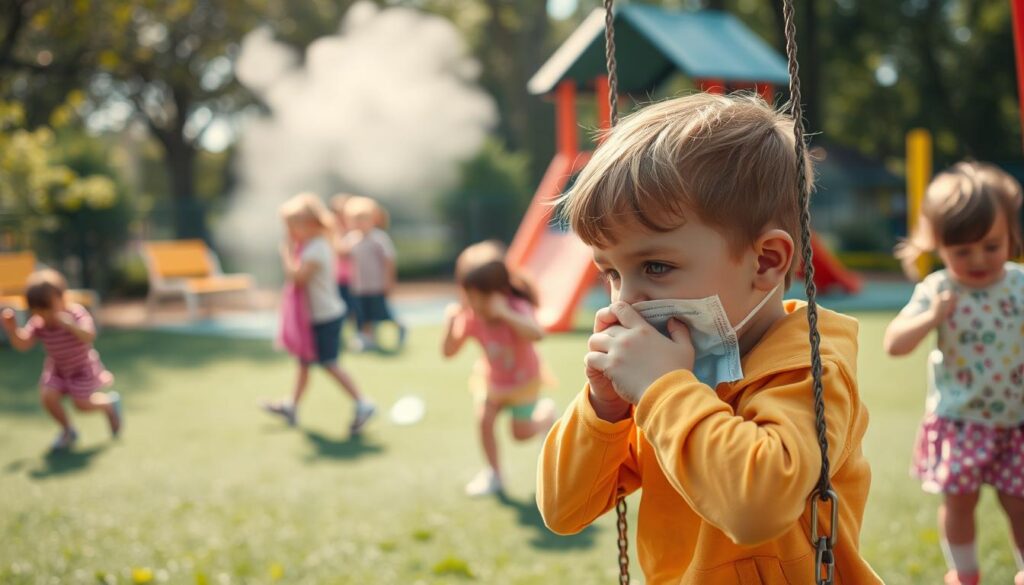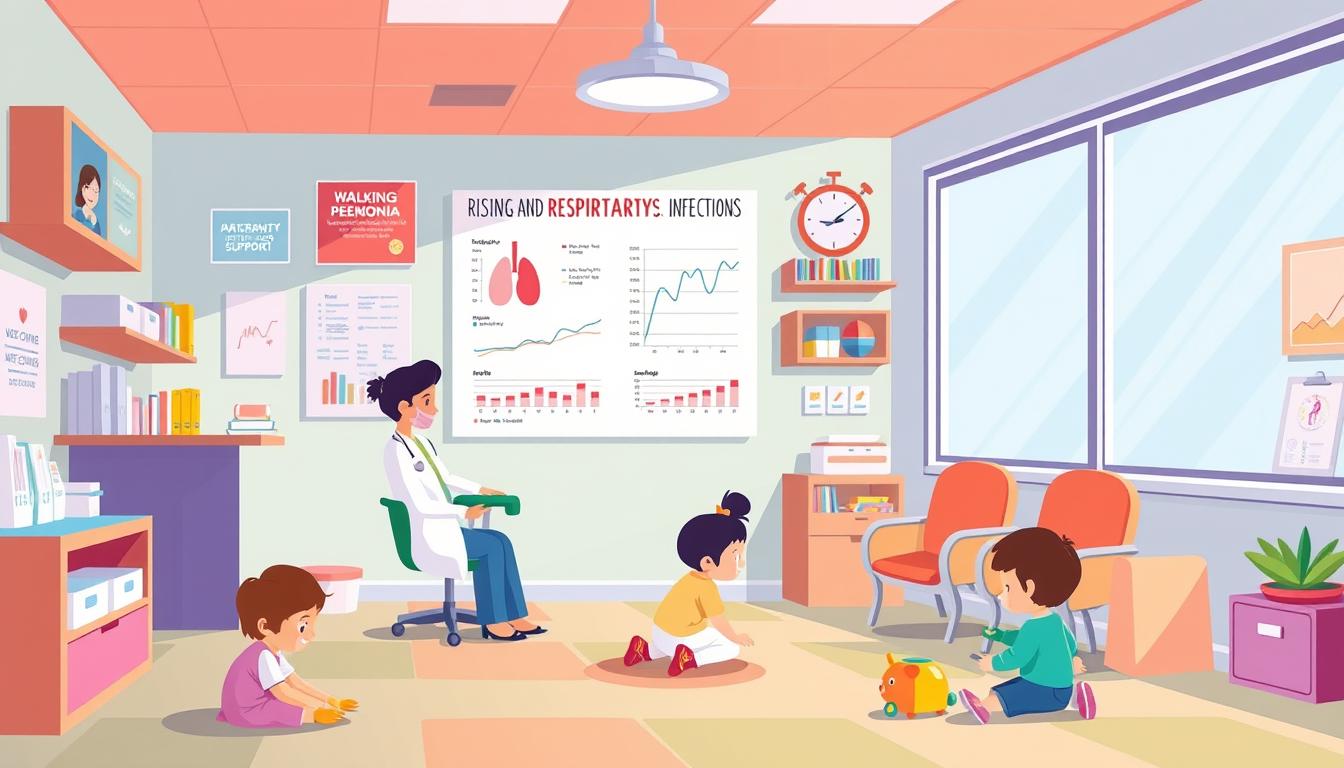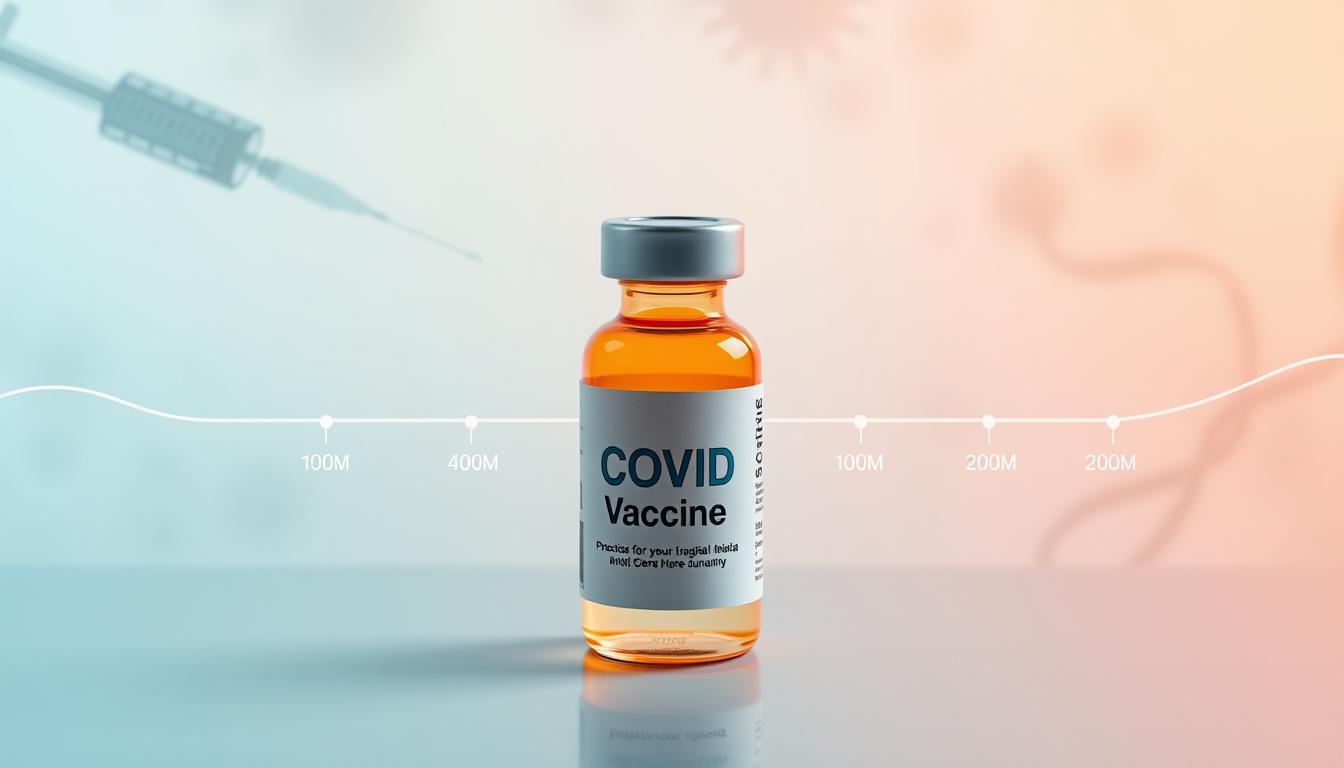The Centers for Disease Control and Prevention (CDC) has issued a warning. They say there’s a big rise in RSV and walking pneumonia in kids. This is happening after a quiet time during the COVID-19 pandemic.
This alert is very important. It’s because more and more kids are getting sick. And it’s affecting kids all over the United States.
Key Takeaways
- The CDC has issued a public alert about the rise in RSV and walking pneumonia cases among children.
- RSV, a respiratory virus, can lead to severe conditions like bronchiolitis and pneumonia, especially in younger children.
- Walking pneumonia cases have significantly increased among children aged 2 to 17 since late spring.
- Preventive measures include regular handwashing, covering coughs/sneezes, and vaccinations.
- The trend indicates a need for heightened awareness and proactive health precautions from parents and caregivers.
Understanding RSV and Its Impact on Children
RSV is very contagious and worries parents a lot. It mainly causes breathing problems in kids. Knowing the symptoms and how serious it can be is key to keeping kids safe.
What is Respiratory Syncytial Virus (RSV)?
RSV is a common virus that causes cold-like symptoms. Most kids get better in a week or two. But, it can be very serious for babies and young kids. It spreads easily when someone coughs or sneezes, especially in places like daycare and school.
Common Symptoms of RSV in Children
Spotting RSV symptoms early is important. Kids often show:
- Runny nose
- Less interest in food
- Coughing
- Sneezing
- Fever
- Wheezing
Watch these signs closely. If they worsen or don’t go away, see a doctor, especially for babies and young kids.
Severe Cases: Bronchiolitis and Pneumonia
RSV can turn into serious problems like bronchiolitis and pneumonia. These are big dangers for babies and kids with health issues. Bronchiolitis is an infection of the small airways, and pneumonia is an infection of the air sacs.
| Region | RSV Vaccination Program |
|---|---|
| Quebec and Ontario | Infant vaccination program with monoclonal antibodies |
| Nova Scotia | RSV vaccine program for high-risk infants; vaccines for seniors starting next month |
Places like Quebec and Ontario are starting vaccination programs for babies. Nova Scotia is focusing on high-risk babies. Soon, seniors in long-term care will also get RSV vaccines. Keeping up with this helps parents protect their kids from RSV.
Walking Pneumonia: Causes, Symptoms, and Risks
Walking pneumonia is a mild lung infection that worries kids and parents. It’s different from regular pneumonia because it has milder symptoms. Knowing about it helps treat and prevent it.
What is Walking Pneumonia?
Walking pneumonia is mainly caused by Mycoplasma pneumoniae. It also comes from other germs, viruses, or mold. Kids, especially in preschool and older, get it more often.
Recently, walking pneumonia cases have gone up a lot. In preschool kids, it rose from 1% to 7.2%. In older kids, it doubled from 3.6% to 7.4%. This infection can be serious if not treated.

Common Symptoms and How It Differs from Regular Pneumonia
Walking pneumonia causes a sore throat, cough, headache, chills, and low fever. It’s milder than regular pneumonia, so kids can still go to school. But, watching these symptoms is important.
Unlike regular pneumonia, walking pneumonia might not need the hospital. It can be treated with antibiotics and other medicines. But, antibiotics like penicillin might not always work.
Risk Factors and Vulnerable Populations
Kids are more at risk for walking pneumonia, especially in places like schools. The CDC says Mycoplasma cases peaked in mid-August and stayed high. This is because of other illnesses like COVID-19 and RSV.
Children with weak immune systems or health problems are especially at risk. So, it’s important to catch it early and prevent it.
| Age Group | Rise in Mycoplasma Cases (%) | Peak Infection Period |
|---|---|---|
| Preschool-aged Children | 1% to 7.2% | Mid-August 2024 |
| Older Children | 3.6% to 7.4% | Mid-August 2024 |
To prevent walking pneumonia, wash hands often and cover coughs and sneezes. It usually goes away in four to six weeks. But, if symptoms get worse, see a doctor.
CDC Alert: Walking pneumonia, RSV rates are rising in young kids, CDC warns
The CDC warning says walking pneumonia and RSV are going up in young kids. This is a big health alert. The Centers for Disease Control and Prevention have new data.
It shows a big jump in cases, especially in kids two to four. ER visits for Mycoplasma pneumonia have gone up a lot. From April 2024 to early October, the number of positive tests went from 1% to 7.2%.
Older kids also saw their cases double, from 3.6% to 7.4%. Doctors think COVID-19 and RSV together might be making things worse. This is making walking pneumonia seem less important during flu and cold season.
| Region | Vaccination Efforts |
|---|---|
| Nova Scotia | Struggling to vaccinate young children with newly authorized RSV vaccines. Currently, vaccines are available only for high-risk infants and pregnant individuals. There is no universally available, publicly funded RSV program for all infants. |
| Quebec and Ontario | Initiated a vaccination program for infants using two monoclonal antibody products. |
| Canada | The National Advisory Committee on Immunization recommended moving towards a universal RSV immunization program for infants. RSV vaccines will soon be available to Nova Scotians aged 60 and older in licensed long-term care facilities. |
We need to watch out for more RSV and walking pneumonia. Washing hands often and covering coughs and sneezes helps stop these illnesses. With the CDC warning, we must keep our kids safe.
Preventive Measures to Keep Your Child Safe
Protecting kids from illnesses like RSV and walking pneumonia is very important. By taking the right steps, we can keep them safe from getting sick.
Everyday Precautions to Reduce Infection Risk
Keeping kids safe from germs is easy. Washing hands often and keeping things clean helps a lot. Also, teach them to cover their mouth when they cough or sneeze.
The Role of Vaccines and Monoclonal Antibodies
Vaccines help kids fight off viruses. Monoclonal antibodies offer extra protection, especially for those at high risk. These tools are key in the fight against RSV and walking pneumonia.
When to Seek Medical Attention
It’s important to know when to go to the doctor. Watch for signs like trouble breathing, high fever, or less appetite and energy. Quick action can stop serious problems and help them get better faster.
| Preventive Measure | Description |
|---|---|
| Handwashing | Regular washing of hands with soap and water to remove germs. |
| Avoiding Crowded Places | Reducing exposure to crowded areas to minimize contact with infected individuals. |
| Vaccines | Immunizations to provide protection against specific viruses. |
| Monoclonal Antibodies | Medical treatments that enhance the immune system’s ability to fight infections. |
| Seeking Medical Attention | Consulting healthcare providers when critical symptoms arise. |
Recent Trends and Data on RSV and Walking Pneumonia
There’s a big rise in RSV and walking pneumonia, especially in young kids in the U.S. This is after the COVID-19 pandemic. We need to look at new trends and old data to understand these infections better.
Statistical Increase of Infections Post-COVID-19
After COVID-19, there’s a big jump in respiratory illnesses. RSV is more active, especially in the south and southeast. Young kids are hit the hardest.
Walking pneumonia, caused by Mycoplasma pneumoniae, is also up a lot. Kids’ hospitals are seeing more cases of walking pneumonia lately.
Regional Variations: Areas with Higher Incidences
Reports show different areas are affected differently. For example, McMaster Children’s Hospital saw more walking pneumonia in late spring. It peaked in September and stayed high in October.
The BC Centre for Disease Control also found more walking pneumonia, especially in those under 20. The Canadian Sentinel Practitioner Surveillance Network agrees, showing a big jump in B.C. compared to before.
Comparing Current Data With Historical Trends
Looking at RSV and walking pneumonia over time shows interesting patterns. For instance, IWK Health in Halifax saw a huge jump in walking pneumonia cases. HSC Children’s Hospital in Winnipeg also saw more pneumonia in kids this fall.
These big increases mean we need to keep watching health reports and RSV data. This helps us get ready for future outbreaks and respond quickly.
| Region | RSV Cases – Increase | Walking Pneumonia Cases – Increase |
|---|---|---|
| Southern USA | High | Moderate |
| Southeastern USA | High | Moderate |
| British Columbia | Moderate | High |
| Alberta | Low | Moderate |
| Ontario | Low | High |
Expert Insights and Parental Experiences
More kids are getting sick with Respiratory Syncytial Virus (RSV) and walking pneumonia. This worries doctors and parents a lot. It’s happening more now than it did during the COVID-19 pandemic.
Healthcare Professionals on the Frontlines
Doctors say these infections are very serious. Dr. Anthony Fauci talks about how fast action is needed. He says finding and treating kids early is very important.
“Timely vaccination and vigilant monitoring can greatly reduce the risk of severe outcomes in children exposed to RSV and walking pneumonia,” says Dr. Fauci.
Parental Concerns and Challenges in Getting Vaccinated
Parents are having a hard time getting vaccines for their kids. They need help figuring out how to get vaccines. Many are upset because there aren’t enough RSV vaccines for babies.
| Challenge | Details |
|---|---|
| Vaccine Availability | Limited supply of RSV vaccines has been a major issue. |
| Healthcare Access | Rural and underserved communities face greater difficulties in accessing healthcare services. |
| Information Misinformation | Parents often encounter conflicting information about vaccine safety and efficacy. |
Doctors and parents agree we need better ways to protect kids. We need more vaccines and easier ways to get them. This way, all kids can stay safe from RSV and walking pneumonia.
Conclusion
RSV and walking pneumonia are on the rise in kids. We need to understand and act fast. Mycoplasma pneumonia cases in kids have jumped, especially in the two to four age group.
Places like Wisconsin and Illinois are seeing more cases. This shows how big the problem is.
Healthcare advice and safety steps are key. Hospitals like Cook Children’s Medical Center in Fort Worth are seeing a lot of cases. This shows we need to be careful and quick to help.
Parents and doctors must work together. We need to stop these infections and keep kids safe.
The world of kids’ respiratory illnesses is changing. This is especially true after COVID-19. Mycoplasma pneumonia outbreaks are happening in many places.
We need to find new ways to treat and prevent these illnesses. With good healthcare advice and safety steps, we can help kids stay healthy.


